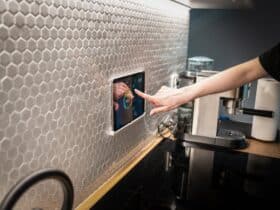The style of tile you choose significantly impacts whether your bathroom feels timeless or trendy. Subway tiles are a classic option that can be incorporated in various ways to look modern and sleek.
One of the most popular uses for subway tile is a herringbone pattern. This layout creates eye-catching depth and a sense of movement.
Brighten Up Your Space
Subway tiles can help brighten up your space. While traditionally white, the tiles can be used in various colors and even be paired with darker wallpaper to create a unique look for your bathroom. Additionally, subway tile can be stacked at various heights to create wainscoting in your bathroom, adding an exciting touch and helping brighten the wall.
Subway tiles can also be arranged in patterns, including herringbone and basketweave. While the classic white 3-by-6-inch tile with its horizontal arrangement never goes out of style, experimenting with other arrangements can make your space more customized.
Another way to add interest to your bathroom is by using a contrasting grout color, like black, with the traditional white tile. The contrasting grout helps to highlight the different shapes and sizes of each tile and creates a bolder design.
The best thing about subway tiles is that they can be used in various applications and any bathroom. They’re tough enough to withstand time and versatile enough to work with any décor. Their classic beauty makes them perfect for kitchens, bathrooms, and powder rooms. And, with MSI’s wide selection of quality tiles in many finishes and colors, you can find the perfect subway tile to match your bathroom’s decor.
Create a Sleek Look
The clean lines and crisp color of subway tile create a modern look that won’t date. This style is especially effective when paired with a natural stone tile or patterned floor.
Subway tiles come in various sizes and finishes to match any bathroom design. You can even find them in different colors, like blue, green, and teal, to create a pop of color. Alternatively, you can choose a neutral shade for an elegant look or contrast your walls with a bold pattern, like the double basketweave pattern featured in this bathroom by Bert & May (opens in new tab).
Another way to add a twist to traditional subway tiles is to use them as wainscoting. Limiting the stacking of the tile to a certain height can give your shower walls a break from the rest of the room, creating a visual effect that can be accented with paint or wallpaper.
Subway tiles are also a good choice for kitchens and powder rooms since their glossy, glazed surface makes them easy to clean. They originated from Victorian-era fixations on hygiene, but they’ve been a staple in bathrooms ever since. They also make outstanding backsplashes behind sinks and stoves and can even be used on fireplace surrounds (because ceramic tile is flame-resistant). They’re an inexpensive option to bring a high-impact decorative touch to your home.
Easy to Clean
The classic white color of subway tile is impervious to bacteria and easy to clean with a simple wipe-down. This makes it an excellent choice for busy households, and the texture of the tiles also creates a slip-resistant surface that’s easy to maneuver in and out of the shower.
The timeless subway tile design can be a great way to add character and flair to any bathroom. While many still think of subway tile as a three-by-six-inch square, it’s now available in various colors and materials, including ceramic, porcelain, glass, travertine, and marble. It’s not always necessary to stick with the standard rectangular shape either: a herringbone pattern in a dark gray tile is visually exciting and eye-catching, as demonstrated in this gorgeous bathroom by Cathie Hong Interiors (opens in new tab).
While subway tiles are often seen in neutral, monochrome hues, they can be used boldly and dramatically. For example, a herringbone pattern can be stacked, creating a dramatic and contemporary look. Or, the tiles can be positioned vertically to accentuate the ceiling height in a room, as illustrated here in this stunning bathroom by Waterworks (opens in a new tab). Incorporating grout color into a subway tile shower is also an effective way to change the design, blending, contrasting, or adding more depth.
Versatile
A classic style for kitchens and bathrooms, subway tiles can be incorporated into designs that range from casual to formal. The tiles first appeared in train stations during the early 1900s, and the qualities that made them well-suited for those high-traffic areas—stain resistant, easy to clean, and light reflective—quickly earned them a place in homes, too.
Today, these versatile three by 6-inch glazed white rectangles can be found in bathrooms and kitchens worldwide. They’re still famous for backsplashes but can also be used to frame showers, create unique flooring options, and decorate fireplace surrounds.
The variety of tile colors, grout color and texture, layout patterns, and finish types available for subway tiles means endless possibilities for design. For example, you can play around with the standard layout pattern of a stacked subway tile or try something different, like a herringbone pattern, to achieve a unique look.
Whether you’re looking to soften a contemporary bathroom or bring an old-school flair to a traditional kitchen or bathroom, there are plenty of ways to incorporate subway tiles into your design plans. Check out our gallery for a variety of inspiring subway bathroom ideas. You can also read our blog post for everything you need to know about choosing the best grout for your project, as this element is just as crucial as your tile selection!










